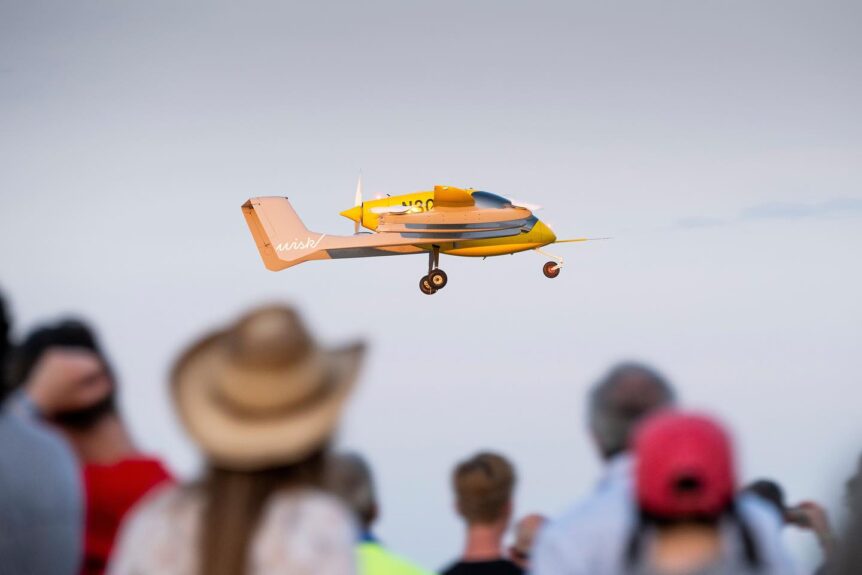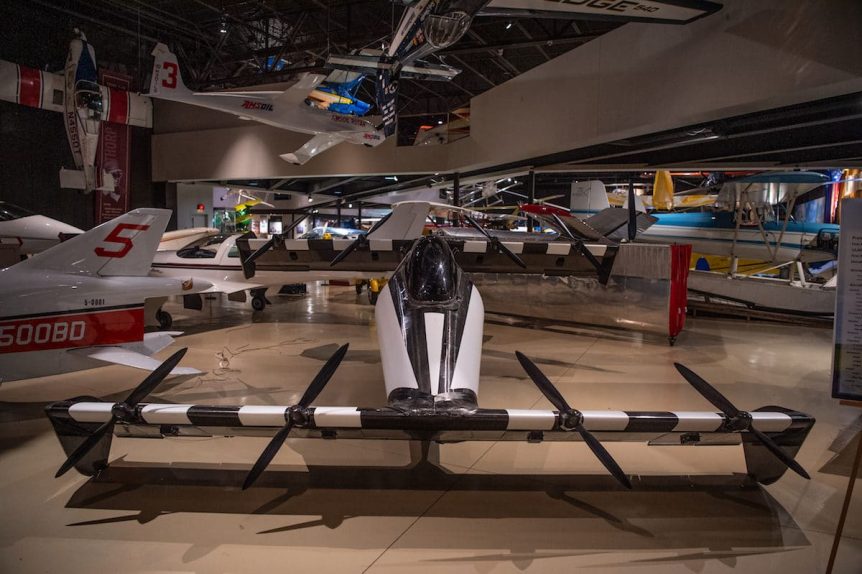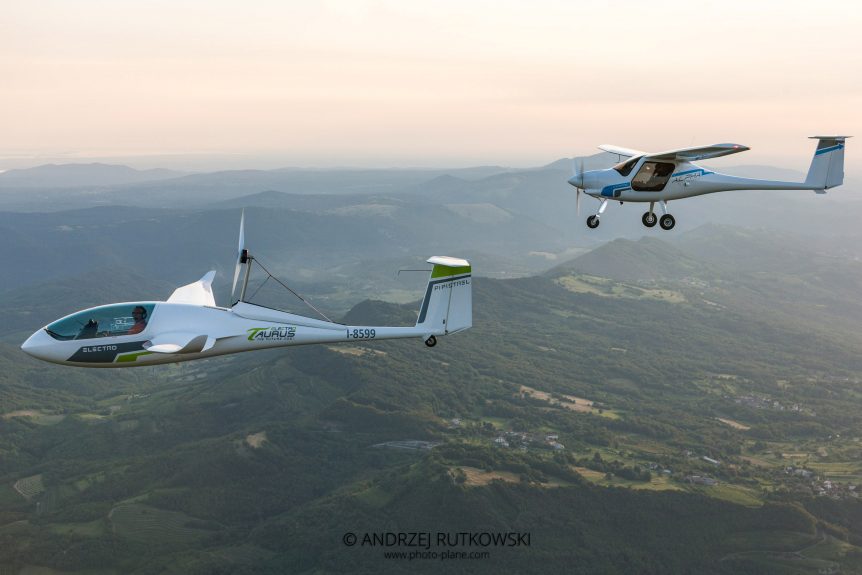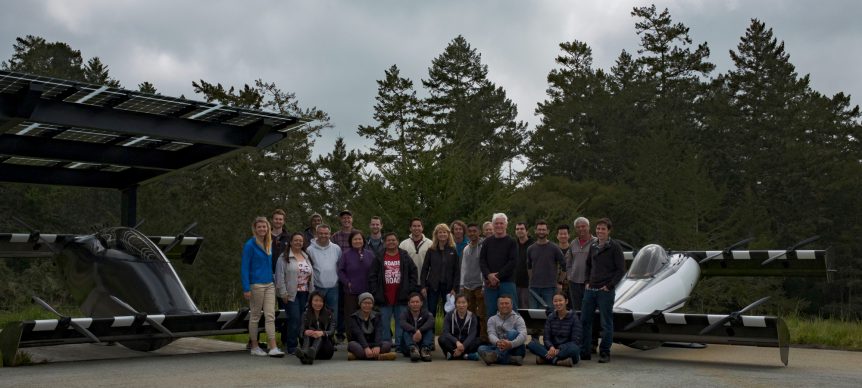A Wisk Cora flew autonomously several times along the length of the 8,002-foot main runway, a first at the Experimental Aircraft Association’s 2023 AirVenture in Oshkosh, Wisconsin. The July 25 event was, “The first-ever public demonstration of a fully autonomous eVTOL fixed-wing airtaxi,” according to the company. Under development and appearing in different configurations over the last several years Wisk’s aircraft have flown in Hollister, California and in New Zealand. Cora represents the fifth generation of such vehicles. Wisk, a Boeing partner, is not stopping there. The flight from another perspective, with an explanation of the noise on the soundtrack: “The noise is the 787 APU, not the @WiskAero. ‘ Note how the noise drops as the auxiliary power unit shuts down, with crowd noise competing with the Cora for dominance. https://twitter.com/i/status/1684023361804943360 A Future with Four Seats The latest iteration for the firm is their sixth-generation craft, simply called Generation Six. It’s a four-seater, with ample room for passengers and …
Look! Up in the Sky! At Oshkosh
Two different machines, with vastly different purposes and unique looks, are flying electrically above Wittman Field for the worlds’ biggest airshow. The Experimental Aircraft Association’s gathering, having skipped a year because of the pandemic, is back with nearly twice the number of attendees. It’s a crowd ready to be rocked. Volocopter Helena Treeck, head of public relations for Volocopter GmbH, is on scene at AirVenture, not only promoting her company’s machines, but granting interviews and reporting herself. She shares the experience. “The crewed Volocopter 2X took off at 2:45 PM CST for a 4-minute flight at ~164 feet and a top speed of 18 mph over Wittman Regional Airport as part of EAA’s AirVenture aviation celebration. Event attendees were able to watch the Volocopter 2X fly and take a seat in the VoloCity model at Volocopter’s booth to experience these aircraft. Nicknamed the ‘World’s Greatest Aviation Celebration,’ more than 600,000 visitors are expected to come to see pioneering designs in …
Pipistrel Velis: Part of an Electric Heritage
The Pipistrel Velis is the culmination of 13 years of electric aircraft development and the first to gain certification by the European Union Aviation Safety Agency (EASA) on June 10. Pipistrel has been in the electric airplane business since 2007 when it announced the Taurus Electro motorglider, which entered service in 2011. That aircraft went through several iterations, and is still part of the Pipistrel lineup of electric planes, which includes the Alpha Electro Trainer, the Panthera Hybrid, and the new Velis. Alpha Electro Trainer in SoCal An electric version of the Alpha Trainer, the Electro has been in production since 2015. With an empty weight of 615 pounds (279 kg) and a maximum take-off weight of 1,212 pounds (550 kg), it is a bit heavier than the Rotax-powered gas version, and carries about 100 pounds less payload. Both have similar performance, though, with rates of climb around 1,200 feet per minute. Joseph Oldham started a well-organized, well-intentioned operation to …
Just for Openers – BlackFly
A Seven-Year Stealth Project Opener doesn’t sound like the name of an airplane company, and BlackFly doesn’t sound like a very charming name for an airplane. Maybe that’s how the developers of an eight-motor personal flying machine got away with it for so long. Beth Stanton, who writes wonderful articles about futuristic projects for the Experimental Aircraft Association’s Sport Aviation magazine, alerted your editor about a project that sneaked under the radar for the past seven years. The airplane looks a bit like a single-seat Vahana, Airbus’s two-seat air taxi currently under test in eastern Oregon. Where Vahana is just beginning flight tests, BlackFly has over 12,000 aerial miles carrying a payload in 1,400 flights. BlackFly has gone through 40,000 cycles on its power system, equivalent to 25 circumnavigations of the earth, according to the company. Three fail-safe flight control systems manage redundant motors, elevens, and batteries. Batteries are arranged in a distributed, isolated system. Pilots are constrained and protected from …
Brian Carpenter’s EMG-6 Webinar
Brian Carpenter, designer of the EMG-6 motorglider which he’s shown over the last several years at AirVenture, will stage a webinar to discuss “the design and development concepts of this new electric motorglider.” His talk will have special “Emphasis on the integration of the electric propulsion concepts that he believes will change the face of the light aircraft and ultralight industry.” Your editor has visited Brian’s Corning, California workshop several times, and always found new and innovative approaches to producing a low-cost, self-launching motorglider, with several ways to simplify construction and to power the craft. It will be interesting to see progress on the newest motor (apparently still under development) Brian has presented on his web site. He has been experimenting with low-budget hydroforming for making repeated metal parts and making plastic parts using 3-D printers. His shop is always worth seeing. The webinar, to be held Wednesday, October 19, 2016 will take place from 7:00 PM – 8:30 PM …
RX1E, Sun Flyer Both Score More than a Score (of Orders)
China Daily reports, “The world’s first electric passenger aircraft to gain an airworthiness certificate has been produced by China.” Whether the “first” certification statement is true will probably become a matter of debate, with Pipistrel’s Alpha Electro being certified in France and seeking more general approvals from other countries including America. Pipistrel has been selling a Taurus Electro G2 self-launching sailplane for the last several years, and makes the following claims for it. “Taurus Electro G2 is the only electric 2-seat aeroplane in serial production available on the market. Furthermore, Pipistrel believes it is the only truly useful electric aircraft out there, because the electric drive is applied to the glider airframe, where battery capacity is not a limiting factor in performance/endurance. Taurus Electro G2 represents a leap forward in performance, safety, functionality and user friendliness.” We noted the RX1E’s certification in the blog a few months ago. It’s in production in China with the first two aircraft delivered to Liaoning …
Dr. Seeley Speaks at AIAA Conference, NASA Dryden
Dr. Brien Seeley, Founder and President of the CAFE Foundation, has been giving a series of talks at the Experimental Aircraft Association’s AirVenture 2013, before a gathering of technical experts at NASA’s Dryden Flight Test Center, Edwards Air Force and at the American Institute of Aeronautics and Astronautics (AIAA) International Powered Lift Conference in Los Angeles. The International Powered Lift Conference focuses on the latest developments in Vertical or Short Takeoff and Landing (V/STOL) aircraft research, concepts, and programs, something of great interest to CAFE in its development of airplanes capable of using pocket airports. Pocket Airports will require a special type of airplane – electric, according to Dr. Seeley, and capable of taking off with a ground roll of 90 feet (home plate to first base), able to climb at an angle that would clear the 150-foot Matterhorn at Disneyland by the time it reaches the end of a 420-foot runway, and being nearly inaudible as it crosses the …
Aviat Flies Dual-Fuel Airplane to Oshkosh
Your editor spent much of his time at AirVenture 2013 in or around the Innovation Pavilion, the Experimental Aircraft Association’s nod to experimentation on a grand scale. Flanking the doors into the pavilion were two approaches to making flight more efficient, the LAM Ailerons on a Cessna Corvallis and a dual-fuel system on an Aviat A1-C Husky CNG; “CNG” standing for “compressed natural gas.” Stu Horn, President of Aviat Aircraft, is proud of the all-American nature of the airplane, most components other than avionics having their origin in this country. Even the fuel for this proof-of-concept Husky is a domestic product, and a possible reflection of its back-country home. Afton, Wyoming, where Aviat makes Huskies, has resurrected the Pitts Special, and continues support for the Aviat (formerly Christen) Eagle. Afton lies within a two-hour drive of Yellowstone National Park, and closer to Salt Lake City or Pocatello, Idaho than any major city in Wyoming. Because of this, many pickups and …
Pipistrel,PADA, and “Gus” Raspet
Pipistel, the innovative Slovenian company that won the Green Flight Challenge with its G4 electric four-seater, continues to earn plaudits from the aviation industry. At this year’s AirVenture, the Experimental Aircraft Association’s annual gathering at Oshkosh, Wisconsin, the company was honored with the Dr. August Raspet Memorial Award and original and pace-setting design work exemplified in Pipistrel products. The Exerimental Aircraft Association has awarded the “Dr. August Raspet Memorial Award” annually since 1960 “to a person who has made outstanding advancements in the field of light aircraft design and the Experimental Aircraft Association.” John Thorp, Lockheed engineer and designer, was the first recipient, with those following including Curtiss Pitts, Burt Rutan, Alan and Dale Klapmeier and Gordon Pratt. Taja Boscarol, in the company’s press release, notes that, “This year’s award being given to the Pipistrel Team is definitely proof that Pipistrel’s innovativeness is now fully recognized and appreciated even in the cradle of the aviation industry, the USA.” Michael Coates, …
Want a Ride in Synergy?
Howard Handelman, a regular reader and observant critic of the CAFE Blog, and Patrick Panzera of Contact magazine fame, are soliciting support for an effort to help John McGinnis finish his Synergy aircraft, unfortunately unable to make its Green Flight Challenge date, but nearing the finish line, none the less. Kickstarter.com recently rejected John’s attempt to raise funds for the nearly complete aircraft, a radically new and somewhat controversial approach to obtaining high performance on relatively low power. John has shared his insights into the aerodynamics of the project and invited a lively discussion (now closed) on the Experimental Aircraft Association’s forums pages. Synergy under construction – an imposing sight The Internet has made possible fund-raising “crowd sourcing” in which interested people all over the world can contribute to enterprises they feel worthy of support. As Handelman explains, “Keep in mind that Gates, Jobs and Rutan started in the equivalent of their garages. Then remember the pre-internet crowd funding of …
- Page 1 of 2
- 1
- 2




